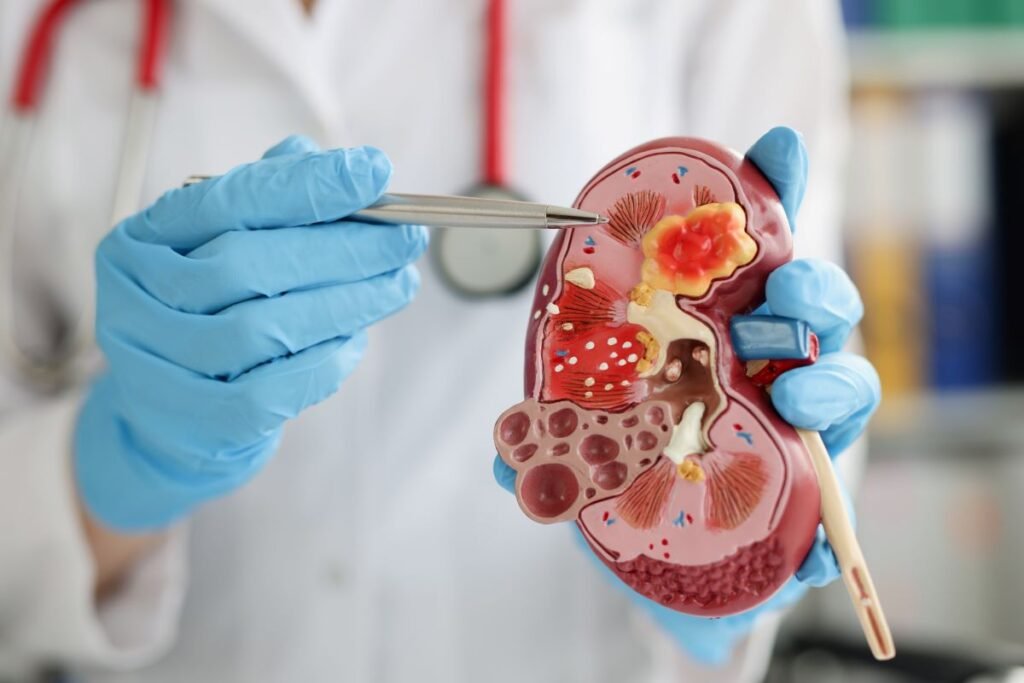Chronic kidney diseases
Introduction
Chronic kidney disease (CKD) is a progressive and irreversible decline in kidney function that usually develops over many years. In the early stages, it can only be present in the form of biochemical abnormalities, with no noticeable symptoms. However, as the situation progresses, the kidneys gradually lose their ability to do the necessary emissions, metabolism and endocrine functions. This decline eventually consists of clinical manifestations of kidney failure, which is collectively known as Uramiia. When the kidney function deteriorates at the point where existence depends on the renal replacement therapy (RRT), the condition is classified as end-phase renal disease (ESRD) to suit the CKD stage 5.

Types of Chronic Kidney Diseases
Epidemiology
Lorem ipsum dolor sit amet, consectetur adipiscing elit. Ut elit tellus, luctus nec ullamcorper mattis, pulvinar dapibus leo.
Pathophysiology
Lorem ipsum dolor sit amet, consectetur adipiscing elit. Ut elit tellus, luctus nec ullamcorper mattis, pulvinar dapibus leo.
Clinical features
Lorem ipsum dolor sit amet, consectetur adipiscing elit. Ut elit tellus, luctus nec ullamcorper mattis, pulvinar dapibus leo.
Investigations
Lorem ipsum dolor sit amet, consectetur adipiscing elit. Ut elit tellus, luctus nec ullamcorper mattis, pulvinar dapibus leo.
Causes CKD (Chronic Kidney Diseases)
- Diabetes is the major cause of CKD, people who are suffering from diabetes are at high risk of kidney damage.
- High blood pressure is the 2nd major cause of CKD.
- Heart disease.
- Kidney stones problem.
- Vasculitis which is inflammation of blood vessels increases the risk of kidney diseases.
- Chemotherapy drugs used for the treatment of cancer.
- Analgesics like ibuprofen, aspirin and naproxen may also lead to kidney damage.
- Use of antibiotics like vancomycin, methicillin, sulfonamides and ciprofloxacin.
- Clot formation in the urinary tract.
- Alcohol consumption.
- Dyes used in imaging tests.
Clinical features of CKD:
Accidental discovery
CKD is often found accidentally through regular blood tests. It is usually identified in high risk patients (eg, diabetes or high blood pressure).
Initial phase (GFR> 30 ml/min/1.73 m g))
Tangible in most patients. There may be some experiences: Nutturia (persistent urination at night) – due to loss of kidney focused capacity. It is a non-specific symptom.
Medium phase (GFR <30 ml/min/1.73 m g))
Symptoms may appear to appear, still often unclear and non-specific: Tiredness Breathing (due to anemia or fluid overload)
Advanced phase (GFR <15–20 ml/min/1.73 m g))
Symptoms become more major and systemic, including: Itching (pruritus) Loss of appetite (anorexia) Decrease in load nausea and vomiting Hiccup
Very advanced kidney failure Severe symptoms may include:
Deep breathing – due to metabolic acidosis Muscle Seizure (fit) Drowsiness and coma.
Symptoms associated with chronic kidney diseases
- Urination at small intervals in larger amount than normal with pale color.
- Less urination than usual with dark color.
- Blood in urine
- Swelling in face, hands, feet, legs and ankles.
- Nausea and vomiting.
- Loss of appetite.
- Shortness of breath.
- Chest pain.
Investigations in chronic kidney
- To assess stability/progression: compare to previous results
Haematuria and proteinuria may indicate glomerular disease and need for biopsy (p. 566).Proteinuria indicates risk of progressive CKD requiring preventive ACE inhibitor or ARB therapy
To identify hyperkalaemia and acidosis
Assessment of renal osteodystrophy
If anaemic, exclude common non-renal explanations, then manage as renal anaemia
Cardiovascular risk high in CKD: treat risk factors aggressively
Consider with obstructive urinary symptoms, persistent haematuria, family history of polycystic kidney disease or progressive CKD. Small kidneys suggest chronicity. Asymmetric renal size suggests renovascular or congenital disease
If dialysis or transplant is planned. Hepatitis B vaccination recommended if seronegative
Consider relevant tests from Box 18.26, especially if the cause of CKD is unknown (ACE = angiotensin-converting enzyme; ARB = angiotensin II receptor blocker; CKD = chronic kidney disease; HIV = human immunodeciency virus; 25(OH)D = 25-hydroxyvitamin D)
